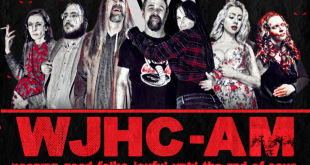Zombies are awesome. I really love a good zombie picture. Hell, they don’t really have to be that good, I still love ‘em. There’s a certain charm about a reanimated corpse wandering mindlessly searching for flesh. Of course, a reanimated corpse is but one kind of zombie. Often an infection, or in the case of Meat Market, microscopic robots cause folks to suddenly want a skin sandwich. Sometimes a film doesn’t even bother to explain why a zombie became that way. Is there then only one true zombie and all else are just the generic undead? Which is the true zombie form? Which is the best?
White Zombie, the 1932 film directed by Victor Halperin and starring Bela Lugosi, is the first zombie film. It would then be logical to look there to find the origin of the (film universe’s) zombie. In this film, Voodoo curse is responsible for birthing the zombie. Subsequent films also featured Voodoo, including I Walked with a Zombie and The Plague of the Zombies. Some of these films were ridiculed in their day for poor acting and weak writing, but are revered today. Better start buying up all the Weekend at Bernie’s 2 DVDs while they are still $1.
In George A. Romero’s 1968 classic Night of the Living Dead, reanimated corpses are the zombies, although the cause of them rising is not really revealed in the film. This zombie is featured is many a film. Whether they be bloodthirsty eternal life seeking Templars (Tombs of the Blind Dead), or cadavers serving as hosts to parasites (Flesh Freaks), the basic zombie sub type here is people risen from the dead, seeking out flesh and/or brains to eat.
The infected are quite a different bunch. Similarly to victims of Voodoo curse (minus Bernie), the infected usually are not dead before they are zombiefied. Generally, there is an outbreak of some sort and a virus is passed via saliva or blood, and there is a window of time (that seems to vary based on whether you are a good guy or a douche bag) that elapses and a new infected is born. The infected like to run fast and are relentlessly hungry, and often prefer techno music and a strobe light effect. The oddly titled yet quite entertaining Zombiebland is an example of this type, as is 28 Days Later.
One of the more interesting choices (yet delivered in stark mediocre film making) was in the film Deadgirl. In this film, there is only 1 zombie, and really, it is merely assumed that she is a zombie. She is at the least immortal, if not the undead. She is found alone in an abandoned asylum, wrapped in plastic. She certainly displays traits of a zombie, having great strength, and survives being beaten and shot (though not in the head). She seems to be able to turn others into whatever she is after biting them. However, after she escapes, there does not seem to be any zombie apocalypse that one would expect. Also, she appears to have feelings as she chooses to spare one of the main character’s lives. However, since she is the only one of her kind, and we never know how she became what she is, this may very well be how the zombies of that film’s universe behave.
The term “zombie” seems to have become a blanket term for all of the undead, no matter how they became that way. If I were writing a dictionary and were at the Z’s, when writing the definition for “zombie,” I would confine it to specifically the dead rising for whatever reason, to feast on the living. The “undead” seems to me to be the better blanket term that may or may not refer to zombies. “Undead” can refer to zombies, infected or even vampires. The above examples are but a few that exist. Which is better? I don’t really think there is any one that is better than the rest or even than any one other sub type. There are however, many films about zombies, some very superior to others. Which ever kind of zombie you prefer, rest assured you will find many a fine film to suit your needs.
 Horror News | HNN Official Site | Horror Movies,Trailers, Reviews
Horror News | HNN Official Site | Horror Movies,Trailers, Reviews





